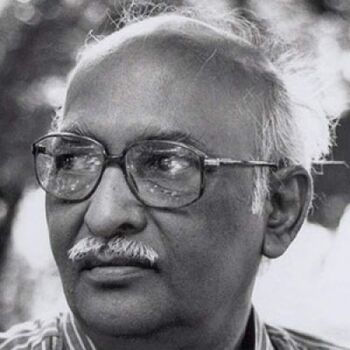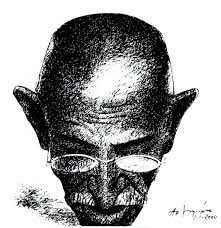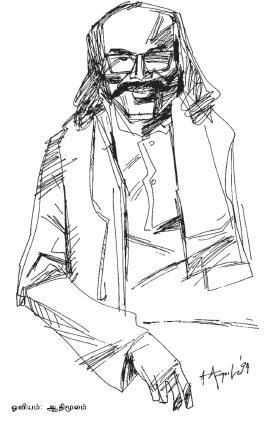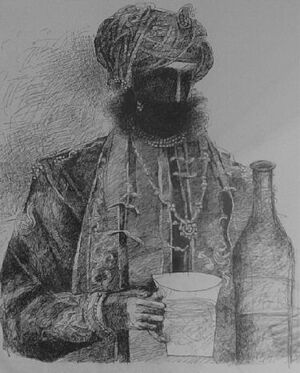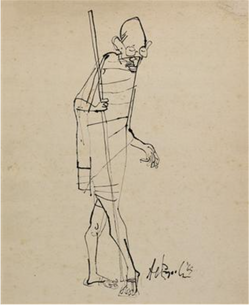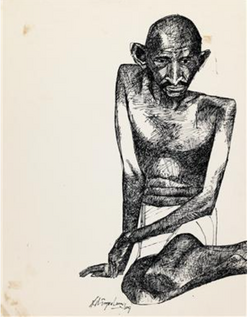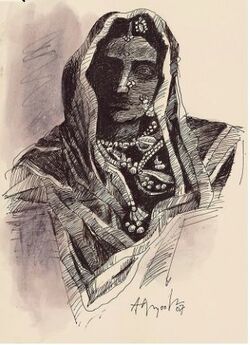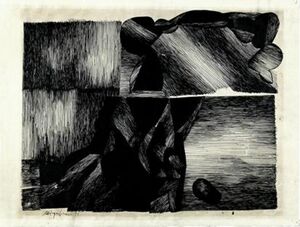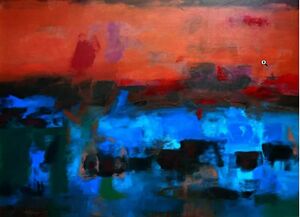K.M. Adimoolam
இந்தப் பக்கத்தை தமிழில் வாசிக்க: கே.எம். ஆதிமூலம்
Kirambur Muthukrishnan Adimoolam (1938 – January 15, 2008), one of the modern artists of Tamil Nadu, who contributed to the Tamil literary sphere with his modern drawings. He designed cover art for books and layout for little magazines, popular magazines and books which brought modern art to the Tamil milieu. K.M. Adimoolam held art exhibitions in India and abroad. He has also been a jury for exhibitions and is a recipient of awards including the Lalit Kala Academy Award.
Birth, Early Life
Adimoolam was born in 1935 in Kirampur, a village between Pachaimalai and Kollimalai, near Thuraiyur in Trichy district, to Muthukrishnan and Chellammal, in an agricultural family of Telugu background. Adimoolam was born as their fourth child. He had two brothers and two sisters. He studied in the Kirampur School till his sixth grade. Later he studied at Zamindar High School, Thuraiyur.
Personal Life
K.M. Adimoolam got married A. Lalitha at the age of 24 and had two sons Aparajithan and Abaneendran.
Art Education, Work
As a child, K.M. Adimoolam was fascinated by carved wooden Utsava Vahanas[1], folkarts like Therukoothu, terracotta horses in the nearby Mariamman temple and the Thanjavur paintings in the Perumal temple. He drew on slate after watching his school art teacher draw. His first sketch was published in Murasoli magazine accompanying a poem by M. Karunanidhi when he was nineteen years old. He has sketched portraits of leaders like E.V. Ramaswamy Periyar, Annadurai and Bharathidasan and has gotten them signed.
K.M. Adimoolam came to Chennai with the help of B.S. Chettiar who was introduced to him by a family friend in 1959. He was also supported by his elder brother K.M. Rangasamy. Adimoolam thought he could draw in magazines or cinema. He was then encouraged to join the Art school (Madras School of Arts and Crafts) by people who saw his art. B.S. Chettiar introduced Adimoolam to the artist Dhanapal. Dhanapal coached Adimoolam to clear the entrance exam to the art school.
K.M. Adimoolam completed six years of art school from 1960 to 1966. There he received training in figurative drawings based on the western curriculum. He traveled to various places in Chennai with a fellow student P. Krishnamoorthy and painted its landscapes, people etc. In 1965, Adimoolam went to a place in Rajasthan called Banasthali for a sixty-day mural training with four other students P. Krishnamoorthy, Bhaskaran, Haridasan and Venkatapathy. When the Cholamandala Artists Village was established, he settled there with his fellow artists. Later he left to build a separate house in Injambakkam near Cholamandalam and lived there.
K.M. Adimoolam started working at the Weavers' Society (Tamil Nadu Handloom Weavers' Cooperative Society or Co-Optex) in 1969 and retired voluntarily in 1989. He has done artworks for many big companies. He was a member of Lalit Kala Academy twice and has been a judge at the National Art Exhibition. K.M. Adimoolam has visited cities abroad including Paris and London.
Artistic Life
Art School
Western artists and their painting styles were introduced to Adimoolam through people like K.C.S. Paniker who was the principal of the Art school. Other great artists of the time like Dhanapal, Santhanaraj, Anthony Dass, L. Munuswamy and Murugesan were also his teachers. Adimoolam developed his own modern style during this period inspired by the traditional art forms he was introduced to, along with the great artists of the West. Adimoolam was influenced by Western painting styles such as Impressionism and Pablo Picasso's Cubism. He has referred to Picasso as his Guru.
Gandhi Drawings
K.M. Adimoolam organized an exhibition of one hundred black-and-white drawings of selected photographs of Gandhi in 1969, on the occasion of the Gandhi's centenary as an expression of his regard for Mahatma Gandhi. These paintings were well known because Gandhi's personality is expressed in a modern form with the influence of Cubism. K.A. Sachithanandam introduced Adimoolam to M. Govindan. Adimoolam's Gandhi paintings were published in Samiksha, a quarterly magazine run by M. Govindan in Kerala and in other Malayalam literary magazines. Gandhi's paintings appeared in the fifth edition of Nadai magazine which was launched in Tamil in 1968.
Illustrations and Cover Art for Literary Journals, Magazines and Books
Adimoolam's rapport with Modern Tamil literature and literary figures enabled him to contribute to the Little Magazine Movement with his illustrations for books and magazines. Jayakanthan and Sundara Ramasamy were the writers who influenced Adimulam. In 1971, when the Kasada Thapara Monthly was launched, Adi Moolam designed the logo with the figure of Ayyanar holding a scythe and a shield in his hands, the font and the layout for the magazine. He created the font for various magazines like Nadai, Navina Virutcham, Yatra and Kalachuvadu based on the script of Tamil epigraphy and palm leaf manuscripts.
K.N. Adimoolam's first book cover art was for the poetry collection Andru Veru Kilamai published by Kriya Ramakrishnan and his friends in 1969 on Gnanakoothan's wedding. Ashokamitran's Kaalamum Ainthu Kulandaigalum, G. Nagarajan's Naalai Matroru Naale, M. Aranganathan's Porulin Porul Kavithai, Imaiyam's Arumugam, Sundara Ramaswamy's Nadunisi Naaigal, Ki. Rajanarayanan's Karisalkaatu Kadithasi and his Gopallapurathu Makkal etc., were some of the books Adimoolam designed layout, cover art and illustrations.
Abstract Paintings
He started painting abstract paintings in 1975. In 1980 he started painting abstract paintings using colors.
Other Paintings
He did drawings of the kings with their faces obscured, dressed in royal robes to depict the disenfranchisement of the Indian kings under the British rule. In 1982, Gnanakoothan brought out a poetry collection called Bharathiyin Pudhu Kavithai for an event celebrating Bharathi's centenary. Adimoolam's painting of Bharathi seated holding a stick for the collection, and his painting of Jayakanthan that appeared in the magazine published for Jayakanthan's 60th birthday are quite well known. He also did Therukoothu paintings and illustrations for Thirukkural. He drew Tirupati Venkatachalapathy and Alamelu Mangai Thayar as seperate paintings. Tirupati Devasthanam printed it on cloth. His paintings have featured in several solo and group exhibitions.
Death
K.M. Adimoolam was diagnosed with cancer in 1998 and was under treatment for ten years. He died on January 15, 2008.
Artistic Significance, Aesthetics
Adimoolam developed a style of his own with his black-and-white drawings. He was influenced by the Tamil art forms such as Therukoothu, Thol paavaikoothu, Terracotta sculptures, Thanjavur paintings while his way of expression bears the influence of modern art movements such as Picasso's Cubism and other such art forms.
Writer Sa. Kandasamy says about Adimoolam, "Adi designed the 'logo' for our magazine Kasada Thapara in 1971. As he came from a rural background, he understood what we were talking about and brought a picture of Ayyanar with a scythe in his hand. We were surprised. We praised him saying 'this is what we wanted'".
Even in Tamil literary circles Modern art movement did not garner widespread appreciation, when it was introduced. The broken forms and distorted elements of Modern art that was far from realistic drawings looked alien to the people then. Adimoolam introduced modern painting through Little magazines and created an acceptance for it in the context of Tamil literature. Modern art was introduced into Tamil popular culture when Adimoolam drew illustrations for Ki. Rajanarayanan's Karisal Kaatu Kadithasi which was serialized in the popular magazine Junior Vikatan. Adimoolam established a relationship between modern Tamil literature and modern painting.
Adimoolam designed fonts used in book cover art, titles and illustrations based on Tamil font style of epigraphs and palm leaf manuscripts[2]. Later this style of font came to be used widely even in Cinema industry.
When Adimoolam was a important committee member at the Lalit kala Academy, artists from Tamil Nadu were recognized for their talent.
Controversies
Adimoolam's modern paintings and his calligraphic designs based on Tamil epigraphy and palm leaf manuscripts were initially not understood and sparked debate. Subsequently these were accepted in the literary sphere and even in popular culture.
In his later years he painted abstract paintings. These paintings were shown in National and International exhibitions and Adimoolam gained recognition but the paintings were criticized because they were not understood in the Tamil cultural sphere
Art Camps
- 1979, Ooty Painting Camp at Lalit kala Academy, Tamil Nadu
- 1980, Lalit kala Academy, Delhi
- 1980, Kasauli Art Camp
- 1981, Kerala Lalit kala Academy
- 1986, SAARC Art Camp, Bangalore
- 1987, Art Camp organised by Lalit kala Academy in Andaman
- 1989, All India Artists Camp, Lucknow
- 1989, Mumbai Art Society Camp
- 1990, ONGC Art Camp, Dehradun
- 1991, South Central Cultural Centre, Gwalior
- 1992, All India Artists Camp, Kanpur
- 1992, National Art Camp, Pondicherry
- 2000, Painting Camp organized by Taj Hotel and Hotel and Art World, Delhi
- 2001, Hampi Art Camp- conducted by Mysore Sales International Limited
Awards
- 1979, National Award, Lalit Kala Academy, New Delhi
- 1978, Lalit Kala Academy, Chennai
- 1973, Academy of Fine Arts, Kolkata
- 1965, 66 Hyderabad Art Society's Award, Hyderabad
- 1965, 66 Mumbai Art Society's Award, Mumbai
- 1965, Lalit Kala Academy, Chennai
- 1964, Lalit Kala Academy, Chennai
- 1963, Chitra Kala Parishad, Bangalore
- 1963, Lalit Kala Academy, Chennai
Exhibitions
Solo Exhibitions
- 2007, 'Lines form an Artistic Life', The Drawings of Adimoolam, Book release and Exhibition, The Mint, New Delhi
- 2007, 'Abstract', Art Motif, New Delhi
- 2006, Solo Show, Saffronart, New York as well as Online Show at Saffronart.com
- 2005, Berkeley Square Gallery, London
- 2003, Crimson Art Resource with Windsor Sheraton, Bangalore
- 2000, Art Heritage, New Delhi
- 1999, Crimson Art Gallery, Bangalore
- 1997, Retrospective Exhibition of Drawings (1962-1996) organized by Values Art Foundation, Chennai and jointly sponsored by Crimson Art Resource and Max Muller Bhavan, Bangalore
- 1994, British Council, Chennai
- 1993, Crimson Art Gallery, Bangalore
- 1987, Jehangir Art Gallery, Mumbai
- 1981, Jehangir Art Gallery, Mumbai
- 1969, Sarala Art Centre, Chennai
- 1969, 100 Drawings on Gandhiji to Mark his Birth Centenary
- 1966, First Solo Show, Chennai
Group Exhibitions
- 2007, 'Six Abstract Artists' Show', Akar Prakar Gallery, Kolkata
- 2006, India Fine Arts, Mumbai
- 2006, Art Motif, New Delhi
- 2006, Organized by Vinyasa Gallery, Chennai at New Delhi, Mumbai, Bangalore, Chennai
- 2004, 'Indian Artists' Show', Prakriti Gallery, Hong Kong
- 2004, 'Still Life', Art Motif, New Delhi
- 2004, Art Motif Gallery, New Delhi
- 2003, 'Five Chennai Artists' Show', Vinyasa Gallery, Chennai
- 2003, Indian and Korean artists at Korea
- 2002, 'Three Artists', Anant Art Gallery, New Delhi
- 2002, 'Landscapes', Art-Motif, New Delhi
- 2001, Art-Motif, New Delhi
- 1999, 'Six Indian Artists', London by Maya Art Gallery
- 1999, 'Small Formats', group show of 6 artists at Chennai, Bangalore, Mumbai and Hyderabad, by Art in Crafts, Bangalore
- 1997, 'Major Trends', group show to commemorate 50 years of India' Independence by Lalit Kala Akademi, New Delhi
- 1997, 'Major Trends', group show to commemorate 50 years of India Independence, jointly sponsored by Crimson Art Resource and Max Muller Bhavan, Bangalore
- 1996 Exhibition to raise funds for Jehangir Art Gallery, Mumbai
- 1996, 'Madras-An Emotion', organized by Values Art Foundation, Chennai
- 1995, 'Gandhiji in Postcard', Traveling Exhibition at Various Cities in India
- 1995, Group show of Indian Artists organized by Saralas Art Center at Tokyo, Japan
- 1995, 'Three Indian Artists Show', Maya Gallery, Hong Kong
- 1995, 'Save the Children', Charity Exhibition at Mumbai
- 1993, 'Wounds', Center of International Modern Art (ClMA), Kolkata
- 1992, Sakshi Gallery, Bangalore
- 1992, Southern Region Art Exhibition by Birla Academy of Art and Culture, Kolkata
- 1991, '9 Indian Artists' by Walk-in-Gallery, Singapore
- 1991, 'Rimbaud-91', organized by Alliance France De Chennai, in Chennai and France
- 1990, Sakshi Gallery, Chennai
- 1990, Dhoomimal Art Centre, New Delhi
- 1990 & 91, 'Touch Stone' shows by Sakshi Gallery Chennai and Bangalore
- 1989, 'Nature and Environment', exhibition organized by Lalit Kala Academy, New Delhi
- 1988, Sakshi Gallery, Chennai
- 1983 & 84, 'Sketch Book Series' (drawings) Sarala Art Center Chennai and Kritika Art Gallery, Bangalore
- 1983, Art Heritage Show, New Delhi
- 1973, Seven South Indian Painters, Australia
- 1972, Twenty Five Years of Indian Art, New Delhi
Collective Exhibitions
- 2003, Forum Art Gallery, Chennai
- 2001, Jehangir Art Gallery, Mumbai
- 1995, Jehangir Art Gallery, Mumbai
- 1993, Jehangir Art Gallery, Mumbai
- 1991, Jehangir Art Gallery, Mumbai
Retrospective Exhibitions
- 2012, 'One Eye Sees, the Other Feels', The Viewing Room, Mumbai
- 2010, 'Who Has Seen Gandhi?', presented by Tangerine Art Space at Raj Bhavan; KynKyny Art Gallery and Tangerine Art Space, Bangalore
- 2010, 'K M Adimoolam: A Retrospective', Jehangir Art Gallery, Mumbai
- 2009, 'Indian Harvest', presented by Crimson- The Art Resource, Bangalore at SG Private Banking, Singapore
- 2008, 'From Beyond The Vindhyas', Ganges Art, Kolkata
Important Participations
- 1993, Jury for National Art Exhibition, New Delhi
- 1992, Jury for Indian Art Exhibition conducted by Mumbai Art Society
- 1991, Coordinator of 'Drawings India-91' by New Delhi Lalita Kala Academy
- 1987, 19th Sao Pa
Books
- Uyir Kodugal (Selected Lines from Ki. Rajanarayanan's Karisal kaatu Kadithasi, Gopallapurathu Makkal and line drawings by Adimoolam)
- Lines from an Artistic Life: The Drawings of Adimoolam, Lund Humphries Publishers Ltd (March 28, 2008)
- The Art of Adimoolam, Gayatri Sinha, Mapin Publishing, 2005
References
- http://andhimazhai.com/news/view/seo-title-89.html
- http://old.thinnai.com/?p=50801173
- https://abedheen.wordpress.com/2012/12/26/adimoolam/
- https://www.youtube.com/watch?v=iSlJcvxVOO0&ab_channel=MagicLanternMovies
Footnotes
- ↑ ‘Vahanas’ refer to the shoulder-borne conveyances—usually in the form of an animal or a character from the mythology associated with the deity. This is used to carry the Utsava Murthy in a procession during festivals (utsavas).
- ↑ The particular style of hand writing used in Tamil epigraphy which were carved using chisel and palm leaf manuscripts which used stylus influenced the font styles by Adimoolam
✅Finalised Page
First published on:
28-Oct-2022, 17:10:07 IST
